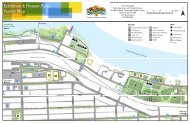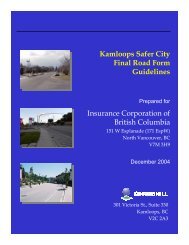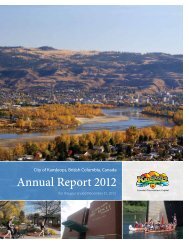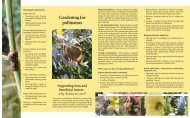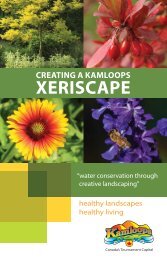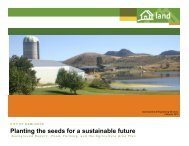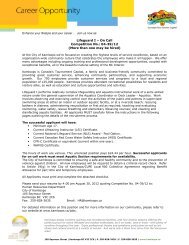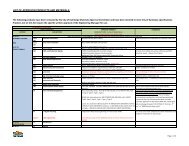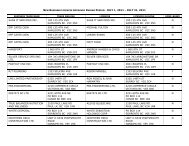FireSmart Home Owners Manual - Wildfire Management Branch
FireSmart Home Owners Manual - Wildfire Management Branch
FireSmart Home Owners Manual - Wildfire Management Branch
You also want an ePaper? Increase the reach of your titles
YUMPU automatically turns print PDFs into web optimized ePapers that Google loves.
1The Rural RealityWildland forest fires are capable of spreading at an astonishing rate. Crowningforest fires often spread at up to 5.5 kilometres per hour, with spotting as faras 2 kilometres ahead. Wind blown grass fires can spread at speeds up to 8.5kilometres per hour.In British Columbia, an average 48% of all wildfires are caused by humanactivity. <strong>Wildfire</strong> is also a natural phenomenon. Nearly 52% of BritishColumbia’s wildfires are caused by lightning strikes. Over the last several centuries,large areas of British Columbia have been burned over repeatedly.Over the last 10 years, on average over 2,500 wildfires were started in BritishColumbia each year consuming over 25,000 hectares of forested land annually.Thousands of families were recently evacuated from their communities andhundreds of homes destroyed.If you live in or near a forested region of our province, sooner or later youmay have to contend with the spread of a wildfire. The best protection againstloss, damage or injury due to wildfire is prevention.Following the <strong>FireSmart</strong> <strong>Home</strong> <strong>Owners</strong> <strong>Manual</strong> can help reduce that risk.PHOTO: BC FOREST SERVICE
2Get ReadyProperly preparing your home and community doesn’t guarantee that youwill not incur fire damage, but it does reduce the risks. Obtain insurancecoverage for all property at risk from fire – government disaster financialassistance is limited and only covers uninsurable perils.Some of these preventative measures cost very little and reduce fire dangers bya great deal; others require planning and a long-term commitment to change.Let’s look at three areas where you can apply <strong>FireSmart</strong> standards to protector reduce the damage to your property should a wildfire strike.Site PreparationInterface Priority ZonesAny kind of vegetation iscombustible.Mature trees, shrubs, grass, evenyour woodpile, are all potentialfuels and can easily ignite (increasingthe chance of building ignitionand loss.) Managing the spacearound your house and buildings isof prime importance.This diagram shows thePriority Zones surroundingan interface building orgroup of buildings.Do you have a cleared zone around your houseand buildings?The first 10 metres of space around your homeis your “First Priority”. It’s the most critical areato consider for fire protection. A good fuel freespace gives firefighters a chance to save yourhome from an advancing fire. A home without agood fuel free space around it can make firefightingdifficult, if not impossible.What to do?Remove any shrubs, trees, deadfall or woodpilesfrom this area and keep your grass mowed andwatered.
3How <strong>FireSmart</strong> is your “Second Priority” zone?From 10 to 30 metres out from your home is the second priority zone. In thiszone, you need to reduce fuels by thinning and pruning so that combustioncannot be supported.What to do?Remove trees and debris thatcan spread fire upwards tobecome a fast spreading crownfire. Space trees so that thecrowns of individual trees are3 - 6 metres apart.Remove or reduce the numberof evergreen trees in thearea. Evergreens such as pineand spruce are much moreLow stand density where trees are widely spaced and crowns donot touch or overlap.combustible than deciduous trees. In fact, aspen, poplar and birch all have verylow flammability rates.Remove deadfall, thick shrubbery and mature trees that might provide theopportunity for a ground fire to climb up into the forest canopy. Once a firecrowns out, it’s virtually unstoppable.Because fires spread more easily up hill, it’s important to extend the secondpriority zone precautions further on downhill slopes and on windward exposures.Can you extend your <strong>FireSmart</strong> maintenance plan to the “Third Priority” zone?The third priority zone begins 30metres from any structure andextends to a distance of 100 metresand beyond. The idea here is not toremove all combustible fuels from theforest, but to thin the area so fires willbe of low intensity and more easilyextinguished.What to do?Thin or reduce shrubs and trees thatmake up the under story, retain fireresistant deciduous trees, space trees(3 - 6 metres between crowns) to reducethe potential for a crowning fire.Lawn or non-combustible material- within 10 metres of building (0 pts).- within 10 - 30 metres of building (0 pts).PHOTO: RICK ARTHURThese are…simple economical steps anyone can take to create a <strong>FireSmart</strong> home, communityor business site. For these actions to be effective, they must be maintained.
5Is your home vulnerable to firebrand ignitions?If you are designing your home, try to eliminate areas where airborne sparksand embers could accumulate and ignite siding, windowsills or trim. Exteriorsiding should be fire resistant and extend from ground level to the roofline.Eaves and vents (onattics and crawlspaces)are ready-made openingsthat can allow heat andembers to enter a buildingand ignite it. Ensureeaves are closed in andscreen all vents includingsoffits. Keep areas underdecks and porches clearof debris and sheathin the undersides ofbalconies and decks withflame resistant materials.Closed eaves,vents screenedwith 3-millimetremesh andaccessible (0 pts)Are your doors and windows<strong>FireSmart</strong>?Clear concentrations of fuels within10 metres of glazed openings. Greaterprotection is provided by smallerdouble or thermal pane or temperedglass windows. Single pane glassprovides virtually no protection.Closed eaves,vents notscreened with3-millimetremesh (1 pt)Single pane (2 or 4 pts)Open eaves,vents notscreened (6 pts)PHOTO: KELVIN HIRSCH PHOTOS: DON MORTIMERTempered (0 pts) - optimum protection isprovided by tempered glass.PHOTO: PELLA WINDOWSDouble pane (1 or 2 pts) - moderate protectionis provided by double or thermal pane windows.PHOTO: PELLA WINDOWS
6Don’t Be the Cause of a <strong>Wildfire</strong>Interface fires often start as smallaccidental ignitions. <strong>FireSmart</strong>standards are aimed at helpinginterface residents to preventinterface fires from starting.<strong>FireSmart</strong> your chimneyChimneys should be constructedto meet current British Columbiabuilding code requirements andshould have approved sparkarrestors.Burn barrelsBurn barrels should be located wellaway from buildings and othercombustible items. Burn barrelsshould have proper ventilation,screens and should never be left burningunattended. For safer disposal,bring your debris to a landfill site.Power lines and propane tanksVegetation should be cleared wellback from power lines, propane tanksand other fuel supplies.Emergency facilities<strong>FireSmart</strong> building sites haveadequate emergency vehicle access,with an on-site emergency water supply(pool, pond or tank).Contact utility companies for clearing of vegetationunder overhead electrical installations.Shovels and rakesEvery home should have shovels, rakes, axes, garden hoses, sprinklers and roofladders to assist in suppressing wildfires.PHOTO: BRIAN MOTTUS
7A Well Thought Out<strong>FireSmart</strong> Protection PlanDIQOKMJEFNPRCHBGLAA Prune tree branches to a height of 2 metres or moreB Store fire wood 10 metres or more from the house (avoid downslope location)C Remove all trees, long grass, shrubs, logs, branches, twigs and needles within 10metres of houseD Thin trees (with 3 - 6 metres between crowns) for at least 30 metres from the houseE Contact your utility company if trees or branches are not clear of power linesF Grass within 10 metres of buildings should be mowed and wateredG Address, fire or lot number clearly signed for quick identification by fire serviceH Driveway is wide enough to accommodate emergency vehiclesI Try to provide an alternate emergency access route to your propertyJ Pond or tank with emergency water supplyK A <strong>FireSmart</strong> burning barrelL Driveway clear of trees to a distance of at least 3 or 4 metresM Chimney installed to code complete with spark arrestor screensN All eaves enclosed and screen all vents including soffitsO Undersides of balconies, decks and crawlspaces sheathed in with flame resistantmaterialsP Propane tanks located at least 10m from building - clear all vegetation within 3 metresQ Use only fire retardant roofing rated Class A, B or C and fire resistant exterior sidingR Solid shutters or metal firescreens will provide increased fire protection for windowsand doors
8Do Your Own <strong>Home</strong> andSite Hazard AssessmentAssign yourself the indicated number of points for each assessment area. Thefewer points you get, the more prepared your property is to successfully survivea wildfire. If a question does not apply to your home, score 0.PHOTO: CDFWill your home survive a wildfire?
9<strong>Home</strong> & Site Hazard AssessmentImportant Characteristics Point YourFactors of Material Rating ScoreWhat kind of roofing If you have asphalt shingles, metal,material do you have? clay tile or ULC rated shakes 0If you haveunrated wooden shakes 30How clean is your roof?No needles, leaves or othercombustible materials 0A scattering of needles and leaves 2Clogged gutters and extensive leaf litter 3What is the exterior of Non-combustible materialyour home built out of? stucco, metal siding, brick 0Logs or heavy timbers 1Wood, vinyl siding or wood shakes 6Are your eaves and vents Closed eaves and vents with 3 mmclosed up and screened? wire mesh 0Closed eaves and vents with no mesh 1Open eaves, open vents 6Have you screened in your All decks, balconies and porches arebalcony, deck or porch? screened or sheathed in with fireresistant material 0All decks, balconies and porches arescreened or sheathed withcombustible material 2Decks, balconies and porches are notscreened or sheathed in 6How fire resistant are your Tempered glass in all doors/windows 0windows and doors? Double pane glass:• Small/Medium 1• Large 2Single pane glass:• Small/Medium 2• Large 4Where is your woodpile More than 10 metres from anylocated? building 0Less than 10 metres fromany building 6Is your home set back Building is located on the bottomfrom the edge of a slope? or lower portion of a hill. 0Building located on the mid toupper portion or crest of a hill 6
10<strong>Home</strong> & Site Hazard AssessmentImportant Potential Point YourFactors Hazards Rating ScoreWhat type of forest Deciduous trees (poplar, birch)surrounds your home, within 10 metres of buildings 0and how far away is it? Deciduous trees 10 - 30 metresfrom buildings 0Mixed wood (poplar, birch,spruce or pine) within 10 metresof buildings 30Mixed wood 10 - 30 metresfrom buildings 10Conifers (spruce, pine or fir)within 10 metres of buildings• separated 30• continuous 30Conifers (spruce, pine or fir)within 10 - 30 metres of buildings• separated 10• continuous 30What kind of vegetation Well watered lawn or nongrowsin the zone combustible landscaping material 0around your buildings? Uncut wild grass or shrubs• within 10 metres of buildings 30• within 10 - 30 metres of buildings 5Dead and down woody materialwithin 10 metres of buildings• scattered 30• abundant 30Dead and down woody materialwithin 10 - 30 metres of buildings• scattered 5• abundant 30Are there abundant None within 10 - 30 metres 0underbrush and ladder Scatteredfuels in the surrounding • within 10 - 30 metres of buildings 5forest?Abundant• within 10 - 30 metres of buildings 10The <strong>Wildfire</strong> Hazard Level for your home is:Total ScoreLow 35 points
11Other <strong>FireSmart</strong> ConsiderationsImportant Factors Yes NoDo you have adequate insurance on yourhome and property?Do you have the necessary firesuppression equipment (shovels, rakes,buckets, hoses, etc.) easily accessible?Are your burn barrels screened and at least10 metres from combustibles and buildings?Are overhead powerlines clear ofvegetation and at least a tree’s heightaway from nearest forest?Are propane tanks clear of vegetationand at least 10 metres from dwellingsand other buildings?Are emergency fire services within a 10minute drive from your home?Is your chimney safe?Is your chimney clean?Does it have proper clearances and stack heightswith proper screens and fire arresters?Do you have good access to your property foremergency response vehicles?Is the area within 10 metres of your home and otherbuildings free of trees, flammable vegetation andother combusibles?Do you have an adequate municipal oron site water supply in case of fire?Does your family have an emergencyfire and evacuation plan?
12Emergency Phone NumbersFind and copy down the emergency numbers for your area and keep them ina visible area close to your telephone.Fire Department: ___________________________Police: ___________________________British Columbia Forest ServiceLocal Fire Centre: ___________________________To report a forest fire call:1-800-663-5555 or *5555 on your cell phoneProperty Identification:Section ______ Township______ Range ______ Other ___________________OrLot ______ Blk ______ Plan______ Other ______________________________OrStreet Address _____________________________________________________For more information about protecting your home and community fromwildfire, order a detailed copy of “<strong>FireSmart</strong> – Protecting Your Communityfrom <strong>Wildfire</strong>”. Copies available from Partners in Protection, phone (780) 435-7283 or http://www.partnersinprotection.ab.ca/downloads/index.shtml or fromthe British Columbia Ministry of Forests, Forest Protection <strong>Branch</strong> office.For more information on fire prevention, detection and suppressionand burning or travel restrictions, contact our website:http://www.for.gov.bc.ca/protect/<strong>Wildfire</strong> Information Line:1-888-3FOREST or 1-888-336-7378
For more information on the B.C. Forest Service Protection Program,contact the office nearest you:B.C. Forest Service, Protection <strong>Branch</strong> Kamloops Fire Centre2957 Jutland Road, 2 nd floor 4000 Airport RoadP.O. Box 9502, Stn Prov GovtKamloops, B.C. V2B 7X2Victoria, B.C. V9W 9C1 (250) 554-5500Coastal Fire CentreSoutheast Fire Centre665 Allsbrook Road 208 Hughes RoadParksville, B.C. V9P 2T3Castlegar, B.C. V1N 4M5(250) 951-4222 (250) 365-4040Northwest Fire CentreCariboo Fire CentreBag 5000 Airport Road3020 Airport RoadSmithers, B.C. V0G 2N0Williams Lake, B.C. V2G 5M1(250) 847-6600 (250) 989-2600Prince George Fire Centre1011 4 th AvenuePrince George, B.C. V2L 3H9(250) 565-6124BE FIRE SMART!Back cover photo: Steve Grimaldi, BC Forest Service
To reporta forestfire call:1-800-663-5555 or*5555 on your cell phone




